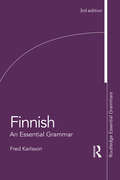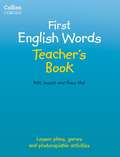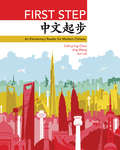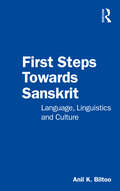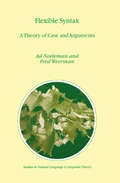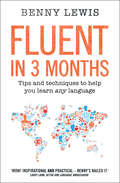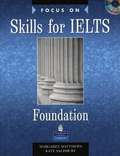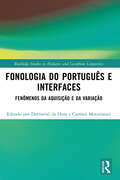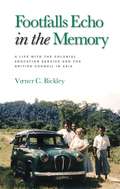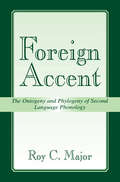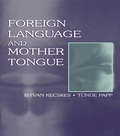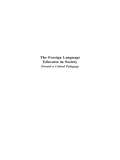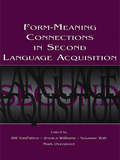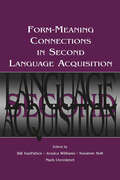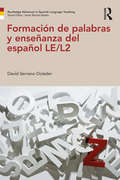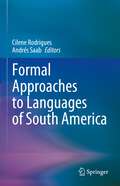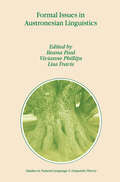- Table View
- List View
Finnish: An Essential Grammar (Routledge Essential Grammars)
by Fred KarlssonThis thoroughly revised third edition of Finnish: An Essential Grammar is grounded in fundamental insights of modern linguistics and incorporates some of the latest achievements in the description of written and spoken Finnish. It gives a systematic account of the structures of the written language and offers increased attention to the key characteristics of present-day colloquial Finnish. No prior knowledge is assumed on the part of the reader and grammatical rules are clearly explained without jargon. Features of this new edition include: • pronunciation guide, including the tendencies in present-day colloquial Finnish • thorough descriptions of morphology (word structure) and syntax (sentence structure) • clear rules and an abundance of concrete examples, from both written and colloquial Finnish • updated vocabulary in the examples • an effective new scheme for detecting the morphological structure of any word form • subject index. This is the ideal reference source both for those studying Finnish independently and for students in schools, colleges, universities and adult classes of all types.
First English Words Teacher's Book (PDF)
by Niki Joseph Hans MolAn essential guide for teachers using First English Words in the classroom. With lesson plans, photocopiable resources and helpful advice, this Teacher’s Book contains all the support you need for using the award-winning picture dictionary First English Words with your young learners. Discover the range of activities that are possible with First English Words and develop a love for learning English amongst children in the classroom.
First Step: An Elementary Reader for Modern Chinese
by Chih-P'Ing Chou Jing Wang Jun LeiFirst Step is an elementary Chinese textbook for students with no previous background in the language. Focusing on the basics of modern Chinese phonetics and grammatical structure, the book uses everyday topics to help students establish a solid foundation in the Chinese language.The textbook, which includes color illustrations, contains thirty lessons, each of which can be covered in a week's worth of classes. Each lesson features a lively dialogue or a short essay, representing a real-life situation, which is then followed by vocabulary lists and grammar notes. Explanatory notes on Chinese culture and customs are also provided. The companion workbook for First Step is sold separately and includes comprehensive exercises and character writing sheets with information on the stroke orders of newly introduced characters. Free online audio files, accessible on smartphones, tablets, and laptops, allow students to listen to First Step dialogues and practice their pronunciation at their leisure. This vital audio supplement gives students the chance to learn Chinese intonation with greater accuracy.First Step provides students with the necessary tools to begin practical daily communication in Chinese.Emphasis is on basic grammar structure and principlesTextbook features both traditional and simplified characters, pinyin, and English translationPerforated workbook (which is sold separately) facilitates easy handling of homeworkFree audio recordings of dialogues and other content available onlineAppropriate for college and high school students
First Steps Towards Sanskrit: Language, Linguistics and Culture
by Anil K. BiltooFirst Steps Towards Sanskrit: Language, Linguistics and Culture is an accessible first introduction to this ancient Indian language. Complete beginners are introduced to the language from scratch. Key terms are explained clearly and there is an extensive glossary to assist the reader who is unfamiliar with the terminology of language learning. By the end of the book, learners will have grasped the basics of the language and be prepared to engage readily in an introductory college or university course or through private study. The addition of cultural, linguistic and historical notes will appeal to learners with diverse interests, ranging from religious studies and philosophy to yoga and comparative or historical linguistics. The book includes references to classical and modern European languages. Parallels are also drawn with Indic languages where these are relevant, particularly as concerns the writing system. No knowledge of any language other than English is, however, presupposed. This book is ideal for both self-study and in-class use as a primer or core text for pre-sessional courses.
First Steps Towards Sanskrit: Language, Linguistics and Culture
by Anil K. BiltooFirst Steps Towards Sanskrit: Language, Linguistics and Culture is an accessible first introduction to this ancient Indian language. Complete beginners are introduced to the language from scratch. Key terms are explained clearly and there is an extensive glossary to assist the reader who is unfamiliar with the terminology of language learning. By the end of the book, learners will have grasped the basics of the language and be prepared to engage readily in an introductory college or university course or through private study. The addition of cultural, linguistic and historical notes will appeal to learners with diverse interests, ranging from religious studies and philosophy to yoga and comparative or historical linguistics. The book includes references to classical and modern European languages. Parallels are also drawn with Indic languages where these are relevant, particularly as concerns the writing system. No knowledge of any language other than English is, however, presupposed. This book is ideal for both self-study and in-class use as a primer or core text for pre-sessional courses.
Flexible Syntax: A Theory of Case and Arguments (Studies in Natural Language and Linguistic Theory #47)
by A. Neeleman F. WeermanMost linguistic theories assume that each grammatical relation is established in a unique structural configuration. Neeleman and Weerman take issue with this view, arguing for a more flexible approach on the basis of conceptual considerations and data taken mostly, but not exclusively, from the Germanic languages. In-depth analyses of word order phenomena as well as diachronic and typological generalizations motivate a re-evaluation of the role of case in the projection of arguments. Case is shown to provide a syntactic foothold for thematic interpretation, something which is necessary in a grammar that does not allow fixed theta-positions. Thus, this study does not only offer a genuine alternative to many standard assumptions, it also explains why there should be such a thing as case in natural language.
Fluent in 3 Months: How Anyone At Any Age Can Learn To Speak Any Language From Anywhere In The World
by Benny LewisMeet the man who makes the mission of learning any language possible! The all-you-need guide to learning a language.
Focus On Skills For Ielts Foundation Book (PDF)
by Margaret Matthews Katy SalisburyAn ideal companion to Focus on IELTS Foundation, this book can also be used independently for short/intensive pre-IELTS courses. ISBN-13: 9781405831642 ISBN-13: 9781405815277 ISBN-10: 1405831642 ISBN-10: 1405815272
Fonologia do Português e Interfaces: Fenômenos da Aquisição e da Variação (Routledge Studies in Hispanic and Lusophone Linguistics)
by Dermeval Da Hora Carmen MatzenauerFonologia do Português e Interfaces: Fenômenos da Aquisição e da Variação brings together a collection of studies on phonological acquisition and phonological variation in European and Brazilian Portuguese, addressing topics and proposing analyzes that are little studied in linguistic research in the target language.The eleven chapters foster theoretical debates on the processes underlying both phonological acquisition and variation and show how these are interrelated. They focus on the acquisition of phonology by children as well as adult variation in the use of phonological units in everyday speech, highlighting linguistic processes that occur in both contexts. The volume combines theory and practices with a focus on language teaching and acquisition.The book will be of interest to Lusophony linguists, particularly those interested in phonological acquisition and variation, and should prove useful to linguistic researchers, practitioners, and students of Portuguese in Europe, Latin America, and the US.Fonologia do Português e Interfaces: Fenômenos da Aquisição e da Variação reúne uma coletânea de estudos sobre aquisição fonológica e variação fonológica no Português Europeu e Brasileiro, com a abordagem de tópicos e a proposição de análises pouco estudados na pesquisa linguística na língua-alvo.Os onze capítulos promovem debates teóricos sobre os processos subjacentes tanto à aquisição quanto à variação fonológica e mostram como estão inter-relacionados. Concentram-se em unidades fonológicas na fala cotidiana na aquisição da fonologia por crianças, bem como na variação na fala de adultos, destacando os processos linguísticos que ocorrem em ambos os contextos. O volume combina teoria e prática com foco no ensino e na aquisição da língua.O livro será de interesse para linguistas da Lusofonia, particularmente para aqueles voltados para a aquisição e a variação fonológica, e deverá ser útil para pesquisadores da área da Linguística, para usuários da língua e para estudantes de Português na Europa, na América Latina e nos Estados Unidos.
Fonologia do Português e Interfaces: Fenômenos da Aquisição e da Variação (Routledge Studies in Hispanic and Lusophone Linguistics)
by Dermeval Da Hora Carmen Matzenauer Javier Muñoz-BasolsFonologia do Português e Interfaces: Fenômenos da Aquisição e da Variação brings together a collection of studies on phonological acquisition and phonological variation in European and Brazilian Portuguese, addressing topics and proposing analyzes that are little studied in linguistic research in the target language.The eleven chapters foster theoretical debates on the processes underlying both phonological acquisition and variation and show how these are interrelated. They focus on the acquisition of phonology by children as well as adult variation in the use of phonological units in everyday speech, highlighting linguistic processes that occur in both contexts. The volume combines theory and practices with a focus on language teaching and acquisition.The book will be of interest to Lusophony linguists, particularly those interested in phonological acquisition and variation, and should prove useful to linguistic researchers, practitioners, and students of Portuguese in Europe, Latin America, and the US.Fonologia do Português e Interfaces: Fenômenos da Aquisição e da Variação reúne uma coletânea de estudos sobre aquisição fonológica e variação fonológica no Português Europeu e Brasileiro, com a abordagem de tópicos e a proposição de análises pouco estudados na pesquisa linguística na língua-alvo.Os onze capítulos promovem debates teóricos sobre os processos subjacentes tanto à aquisição quanto à variação fonológica e mostram como estão inter-relacionados. Concentram-se em unidades fonológicas na fala cotidiana na aquisição da fonologia por crianças, bem como na variação na fala de adultos, destacando os processos linguísticos que ocorrem em ambos os contextos. O volume combina teoria e prática com foco no ensino e na aquisição da língua.O livro será de interesse para linguistas da Lusofonia, particularmente para aqueles voltados para a aquisição e a variação fonológica, e deverá ser útil para pesquisadores da área da Linguística, para usuários da língua e para estudantes de Português na Europa, na América Latina e nos Estados Unidos.
Fontaine and Cultural Mediation: Translation and Reception in Nineteenth-Century German Literature
by Robertson RitchieIn the mid-1880s, the Realist author and Anglophile Theodor Fontane observed:nowhere is so much translation done as in Germany. Characterizing Germany as a special locus of literary translation and reception, Fontane contests a prejudice which has since become a significant problem for nineteenth-century German studies, namely the frequent assessment of the epoch as narrowly national. The present collection of essays by thirteen eminent literary scholars and historians is intended to correct this prejudice: it demonstrates that literary life and production in the nineteenth century were governed by complex networks of intercultural exchange, influence and translation, and it does justice to this complexity through its range of complementary critical approaches, focussing on Fontane, Anglo-German relations, translation, and European reception. In so doing, this book not only offers a nuanced appreciation of literary production and reception in the nineteenth century, but also demonstrates the continued relevance of that period for Germanists today.
Fontaine and Cultural Mediation: Translation and Reception in Nineteenth-Century German Literature
by Ritchie Robertson Michael WhiteIn the mid-1880s, the Realist author and Anglophile Theodor Fontane observed:nowhere is so much translation done as in Germany. Characterizing Germany as a special locus of literary translation and reception, Fontane contests a prejudice which has since become a significant problem for nineteenth-century German studies, namely the frequent assessment of the epoch as narrowly national. The present collection of essays by thirteen eminent literary scholars and historians is intended to correct this prejudice: it demonstrates that literary life and production in the nineteenth century were governed by complex networks of intercultural exchange, influence and translation, and it does justice to this complexity through its range of complementary critical approaches, focussing on Fontane, Anglo-German relations, translation, and European reception. In so doing, this book not only offers a nuanced appreciation of literary production and reception in the nineteenth century, but also demonstrates the continued relevance of that period for Germanists today.
Footfalls Echo in the Memory: A Life with the Colonial Education Service and the British Council in Asia
by Verner C. BickleyThe Education Service was a vital arm of the British Colonial Service while the British Council has been paramount in promoting the English language and culture overseas. But are both agents of British colonialism and neo-colonialism? Or are both simply altruistic purveyors of language and culture to a wider world?Verner Bickley as an Education Officer in the British Colonial Service and in the British Council provides the answer and shows that educational and cultural values were paramount and important in themselves, and through the medium of the near-global English language, vitally important in both culture and technical training. Life in overseas postings was set against a backdrop of turbulent international relations following World War II, including service in the Royal Navy in India and Ceylon, soon to be become independent Sri Lanka. Bickley was Education Officer in Singapore during the tumultuous 1950s, at the time of the Malayan 'Emergency' and in the lead-up to independence in 1957 which he announced on Radio Malaya. His service with the British Council began with a posting to Burma during the premiership of U Nu, struggling with ethnic problems and to be ousted by military coup. And during his time in Indonesia the British Embassy was burnt to the ground by rioters. Later service was in Japan - basking in its success as an emerging economic powerhouse. This is an essentially warm and human story enlivened, especially during the British Council period, by a succession of diverse personalities, including royalty, British and Thai, as well as writers like Anthony Burgess, Graham Greene and Willis Hall and actors such as Donald Sinden, Patrick Stewart and Max Adrian.
Foreign Accent: The Ontogeny and Phylogeny of Second Language Phonology (Second Language Acquisition Research Series)
by Roy C. MajorEven though second-language learners may master the grammar and vocabulary of the new languages, they almost never achieve a native phonology (accent). Scholars and professionals dealing with second-language learners would agree that this is one of the most persistent challenges they face. Now, for the first time, Roy Major's Foreign Accent covers the exploding scholarship in this area and lays out the issues specifically for audiences in the second language acquisition and applied linguistics community.
Foreign Accent: The Ontogeny and Phylogeny of Second Language Phonology (Second Language Acquisition Research Series)
by Roy C. MajorEven though second-language learners may master the grammar and vocabulary of the new languages, they almost never achieve a native phonology (accent). Scholars and professionals dealing with second-language learners would agree that this is one of the most persistent challenges they face. Now, for the first time, Roy Major's Foreign Accent covers the exploding scholarship in this area and lays out the issues specifically for audiences in the second language acquisition and applied linguistics community.
Foreign Language and Mother Tongue
by Istvan Kecskes Tnde PappThis is the first book that discusses the effect of foreign language learning on first language processing. The authors argue that multilingual development is a dynamic and cumulative process characterized by transfer of different nature, and results in a common underlying conceptual base with two or more language channels that constantly interact with each other. Language representation and processing are discussed from a cognitive-pragmatic rather than a lexical-syntactic perspective. This required the review of several crucial issues of L2 acquisition, such as transfer, vocabulary development, conceptual fluency, and pragmatic skills. The authors also reviewed a large body of literature touching on cognitive psychology, linguistics, psycholinguistics, SLA, philosophy, and education in order to explain multilingual development and the positive effect of foreign language learning on the first language. An important read for linguists and language educators alike, this volume: * attempts to explain multilingual development from a cognitive-pragmatic perspective, * argues that foreign language learning has a positive effect on the development and use of mother tongue skills, * relies on research findings of several different disciplines, * builds on the results of quantitative research conducted by the authors, and touches on a wide range of literature.
Foreign Language and Mother Tongue
by Istvan Kecskes Tnde PappThis is the first book that discusses the effect of foreign language learning on first language processing. The authors argue that multilingual development is a dynamic and cumulative process characterized by transfer of different nature, and results in a common underlying conceptual base with two or more language channels that constantly interact with each other. Language representation and processing are discussed from a cognitive-pragmatic rather than a lexical-syntactic perspective. This required the review of several crucial issues of L2 acquisition, such as transfer, vocabulary development, conceptual fluency, and pragmatic skills. The authors also reviewed a large body of literature touching on cognitive psychology, linguistics, psycholinguistics, SLA, philosophy, and education in order to explain multilingual development and the positive effect of foreign language learning on the first language. An important read for linguists and language educators alike, this volume: * attempts to explain multilingual development from a cognitive-pragmatic perspective, * argues that foreign language learning has a positive effect on the development and use of mother tongue skills, * relies on research findings of several different disciplines, * builds on the results of quantitative research conducted by the authors, and touches on a wide range of literature.
The Foreign Language Educator in Society: Toward A Critical Pedagogy
by Timothy G. Reagan Terry A. OsbornThis text brings together two significant domains of educational practice: foreign language education and critical pedagogy--linking them in a way that can help foreign language educators develop a critical awareness of the nature, purposes, and challenges facing foreign language pedagogy. Unique among texts in the field, this is the first to deal explicitly with the social, political, ideological, and economic aspects of language, language learning, and language teaching in our society and to connect the practice of foreign language education with these critical, and crucial, aspects of language and language use. The Foreign Language Educator in Society: Toward A Critical Pedagogy: *emphasizes what teachers and future teachers of foreign languages in this country ought to know and understand about language-- language attitudes, practices, rights, and policy-- and related issues; *focuses on helping students to move beyond pragmatic pedagogical concerns to the social and political concerns relevant to their teaching; and *provides students with the opportunity to develop critical perspectives on the central facets of the language education process. Intended for foreign language education programs at both basic and advanced levels, as well as courses in critical pedagogy, critical language awareness, sociolinguistics, and social and cultural foundations of education, the text provides helpful pedagogical features to direct the reader in applying the content of each chapter to his or her own context.
The Foreign Language Educator in Society: Toward A Critical Pedagogy
by Timothy G. Reagan Terry A. OsbornThis text brings together two significant domains of educational practice: foreign language education and critical pedagogy--linking them in a way that can help foreign language educators develop a critical awareness of the nature, purposes, and challenges facing foreign language pedagogy. Unique among texts in the field, this is the first to deal explicitly with the social, political, ideological, and economic aspects of language, language learning, and language teaching in our society and to connect the practice of foreign language education with these critical, and crucial, aspects of language and language use. The Foreign Language Educator in Society: Toward A Critical Pedagogy: *emphasizes what teachers and future teachers of foreign languages in this country ought to know and understand about language-- language attitudes, practices, rights, and policy-- and related issues; *focuses on helping students to move beyond pragmatic pedagogical concerns to the social and political concerns relevant to their teaching; and *provides students with the opportunity to develop critical perspectives on the central facets of the language education process. Intended for foreign language education programs at both basic and advanced levels, as well as courses in critical pedagogy, critical language awareness, sociolinguistics, and social and cultural foundations of education, the text provides helpful pedagogical features to direct the reader in applying the content of each chapter to his or her own context.
Form-Meaning Connections in Second Language Acquisition (Second Language Acquisition Research Series)
by Bill VanPatten Jessica Williams Susanne Rott Mark OverstreetForm-Meaning Connections in Second Language Acquisition is an interdisciplinary and timely edited book of essays and empirical studies, most of which are based on the papers presented at the Form and Meaning Conference held in Chicago in 2002. The goal of the conference and now of the book is to present linguistic and cognitive approaches to second language acquisition, attempting to integrate external and internal issues in interlanguage development, while outlining directions for future research. The editors address questions, such as: What is the nature and sequence of the form-meaning mapping process? How are these connections made? How are these connections used to construct grammars and lexicons? And, how can conditions and external factors be manipulated to improve the chances of making these form-meaning connections?Contributors to this volume include such second language acquisition scholars as Susan Gass, Nick Ellis, Kathleen Bardovi-Harlig, Catherine Doughty, and Diane Larsen-Freeman. They address these form-meaning issues from a variety of settings and from multiple perspectives.Researchers and graduate students in applied linguistics, cognitive psychology, linguistics, and language pedagogy will find this volume to be an important resource.
Form-Meaning Connections in Second Language Acquisition (Second Language Acquisition Research Series)
by Bill VanPatten Jessica Williams Susanne Rott Mark OverstreetForm-Meaning Connections in Second Language Acquisition is an interdisciplinary and timely edited book of essays and empirical studies, most of which are based on the papers presented at the Form and Meaning Conference held in Chicago in 2002. The goal of the conference and now of the book is to present linguistic and cognitive approaches to second language acquisition, attempting to integrate external and internal issues in interlanguage development, while outlining directions for future research. The editors address questions, such as: What is the nature and sequence of the form-meaning mapping process? How are these connections made? How are these connections used to construct grammars and lexicons? And, how can conditions and external factors be manipulated to improve the chances of making these form-meaning connections?Contributors to this volume include such second language acquisition scholars as Susan Gass, Nick Ellis, Kathleen Bardovi-Harlig, Catherine Doughty, and Diane Larsen-Freeman. They address these form-meaning issues from a variety of settings and from multiple perspectives.Researchers and graduate students in applied linguistics, cognitive psychology, linguistics, and language pedagogy will find this volume to be an important resource.
Formación de palabras y enseñanza del español LE/L2 (Routledge Advances in Spanish Language Teaching)
by David Serrano-DoladerFormación de palabras y enseñanza del español LE/L2 offers a unique combination of theory and practice that guides the reader through the main processes of word formation in Spanish. It provides a detailed analysis of the role of lexical creation in the acquisition of L2 Spanish vocabulary, as well as over a hundred practical self-reflection activities. Key features: • Comprehensive theoretical explanations of word formation, including theoretical and pedagogical principles and their implementation in the teaching of L2 Spanish; • Step-by-step pedagogical introductions to the full range of lexical creation mechanisms in Spanish language, including prefixation, emotive and nonemotive suffixation and composition; • Carefully-chosen lists of relevant issues on lexical morphology with immediate applicability to the teaching of L2 Spanish; • Guided activities with an answer key, which helps the reader to connect theory with practice and to become familiar with the key aspects of Spanish lexical morphology; • Guidelines on how to tackle the teaching of Spanish word formation and vocabulary in an effective and engaging way. Written in a clear and accessible manner, Formación de palabras y enseñanza del español LE/L2 is an essential resource for teachers of Spanish at all levels. It is also an excellent reference book for language teachers who wish to integrate word formation into the teaching of the Spanish language.
Formación de palabras y enseñanza del español LE/L2 (Routledge Advances in Spanish Language Teaching)
by David Serrano-DoladerFormación de palabras y enseñanza del español LE/L2 offers a unique combination of theory and practice that guides the reader through the main processes of word formation in Spanish. It provides a detailed analysis of the role of lexical creation in the acquisition of L2 Spanish vocabulary, as well as over a hundred practical self-reflection activities. Key features: • Comprehensive theoretical explanations of word formation, including theoretical and pedagogical principles and their implementation in the teaching of L2 Spanish; • Step-by-step pedagogical introductions to the full range of lexical creation mechanisms in Spanish language, including prefixation, emotive and nonemotive suffixation and composition; • Carefully-chosen lists of relevant issues on lexical morphology with immediate applicability to the teaching of L2 Spanish; • Guided activities with an answer key, which helps the reader to connect theory with practice and to become familiar with the key aspects of Spanish lexical morphology; • Guidelines on how to tackle the teaching of Spanish word formation and vocabulary in an effective and engaging way. Written in a clear and accessible manner, Formación de palabras y enseñanza del español LE/L2 is an essential resource for teachers of Spanish at all levels. It is also an excellent reference book for language teachers who wish to integrate word formation into the teaching of the Spanish language.
Formal Approaches to Languages of South America
by Cilene Rodrigues Andrés SaabThis book analyzes the linguistic diversity of South America based on approaches deeply rooted in the tradition of formal grammar. The chapters brought together in this contributed volume consider native languages all kinds of languages used in the region, including sign languages, indigenous languages and the romance languages (Portuguese and Spanish) originally introduced by European colonizers which underwent processes of transformation giving rise to new, local grammars. One fourth of the language families of the world are located in South America, but the majority of languages in the region are still understudied and out of the radar of theoretical linguistics mostly because their grammars are not well-known by international researchers. This book aims to fill this gap by bringing together studies rooted in the formal grammar approach first developed by Noam Chomsky, which sees language not only as mere corpora attested in oral and written production, but also as expressions of systems of thought and language production which are essential parts of human cognition. The book is divided in three parts – sign languages, romance languages and indigenous languages –, and brings together studies of the following South American languages: Brazilian Sign Language (Libras - Língua Brasileira de Sinais)Argentinian Sign Language (LSA - Lengua de Señas Argentina)Peruvian Sign Language (LSP- Lengua de Señas Peruana)Brazilian PortugueseChilean and Argentinian SpanishQuechuaParaguayan GuaraniA’ingaeMacro-Jê languages Formal Approaches to the Languages of South America will be an invaluable resource both for theoretical linguists and cognitive scientists by providing access to top quality research on understudied languages and enabling these languages to be incorporated into comparative studies that can contribute to advance the knowledge of general principles governing all human languages.
Formal Issues in Austronesian Linguistics (Studies in Natural Language and Linguistic Theory #49)
by I. Paul V. Phillips Lisa TravisAustronesian languages have long raised interesting questions for generative theories of syntax and morphology. The papers in this volume encompass some of these traditional questions and place them in newer theoretical contexts. Some of the papers also address new issues which add to our understanding of members of this language family on one side and the nature of linguistic theories on the other. There are three broad issues that re-occur throughout the volume - the role and analysis of verbal morphology, the nature of the subject or the topic in these languages, and the interaction of syntax and specificity. The papers in this volume show that as formal theories become more precise, a wider range of language data can be captured, and as the inventory of language data grows, the accuracy of formal linguistic theories improves.
